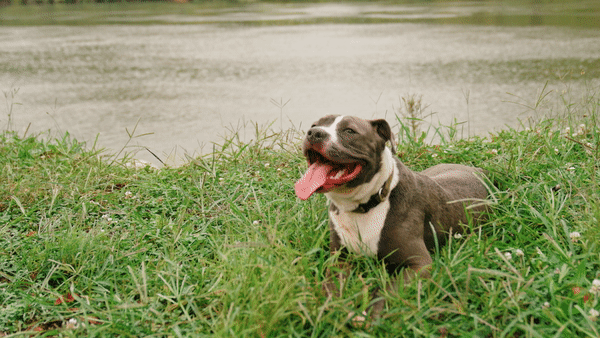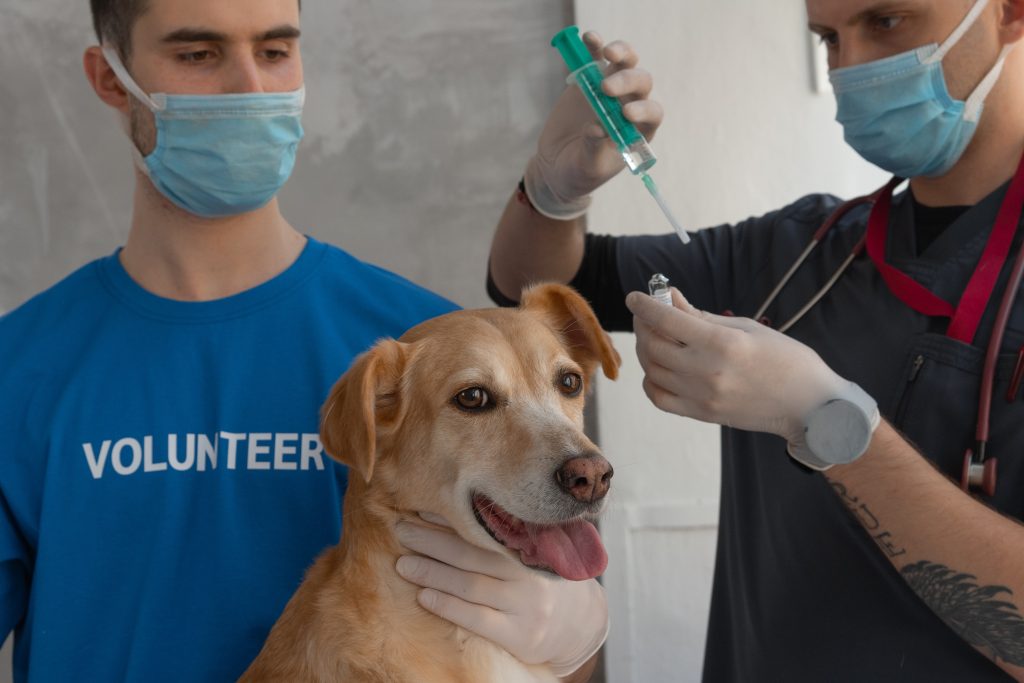As dog owners, we understand seeing our dog panting heavily and showing signs of anxiety can be distressing. This is a common issue.
While pharmacological solutions are available, this article provides natural tips on how to calm a panting dog without relying on medication. Plus, you’ll discover an innovative brand giving natural ways of helping your little buddy deal with anxiety.
Let’s get started!
Click & skip
How to Calm a Panting Dog: 6 Steps

Panting is a natural way for dogs to regulate their body temperature. Still, excessive or heavy panting can indicate stress or discomfort. Here are some tips to help calm down a panting dog:
#1. Stay calm and assess the situation:
Dogs are incredibly perceptive and can sense our emotions. Remaining calm and composed can help reassure your dog that everything is okay.
After that, work on identifying the possible cause of panting, such as heat, anxiety, or pain.
#2. Remove Stressors:
Create a calm environment by removing triggers that may be causing anxiety or discomfort for your dog.
#3. Provide Comfort:
Offer a cool, quiet place for your dog to rest, ensuring access to fresh water and shade. This helps prevent overheating and reduces the need for excessive panting.
#4. Distraction and Mental Stimulation:
Redirecting your dog’s attention through interactive toys or engaging in training exercises can help shift their focus away from stressors, reducing panting and promoting relaxation.
#5. Monitor and Seek Veterinary Advice:
If the panting persists or is accompanied by other concerning symptoms, consult your veterinarian for a thorough evaluation.
#6. Use Calming Techniques:
Employing a gentle massage or using aromatherapy using dog-safe essential oils to help relax your panting dog. However, always consult with a veterinarian before using any essential oils.
Deep breathing exercises are also a great way of reducing your dog’s panting. The only issue is that getting your dog to engage in this behavior requires training, but it can be taught in as short as five minutes.
How to teach your dog breathing exercises

First of all, no, deep-breathing exercises are not the same thing in humans as it is in dogs. Plus, no dog will close its eyes and fill its lungs with air like in a yoga session.
It’s different, but it’s simple. The goal is to stop the dog from breathing rapidly through the mouth and to use its nostrils only instead. You’ll need a treat and a good eye. It goes like this:
Step 1: When your dog is heavily panting, you want him sitting first.
Step 2: Once your dog is sitting, gain his attention by holding a treat in front and above him.
Step 3: Lower yourself and the treat slowly. Get the treat at your dog’s nose height.
Step 4: Get the treat closer and closer to your dog. As you say “breathe,” you want to see him closing his mouth and getting nearer to the treat while flaring his nostrils. That’s the signal you want.
Step 5: If you see him closing his mouth and flaring his nostrils, congrats, you’ve made him take a “deep breath.” Immediately give your dog the treat to encourage this behavior.
Step 6: Asses his behavior after you’ve given him the treat. Did he go back to the heavy panting? If so, repeat the exercise following steps one to five.
Tips to deal with an anxious dog without medication:

Create a Safe Haven:
Dogs are lair animals and enjoy having a safe space to retreat to when they feel anxious. Make sure to have a cozy, designated, quiet area where your dog can relax and feel secure.
Regular Exercise:
Regular physical activity helps reduce anxiety in dogs by releasing endorphins and promoting overall well-being. Engage your dog in daily exercise routines such as walks, playtime, or interactive toys to stimulate them mentally and physically.
Positive Reinforcement:
As we pointed out above, you must reward your dog’s calm behavior with praise, treats, or his favorite toys. This positive reinforcement helps create positive associations and can assist in reducing anxiety over time.
Consistency and Routine:
Dogs thrive on consistency and routine. Establish a predictable daily schedule for feeding, exercise, and rest, as this can provide a sense of security and reduce anxiety.
Soothing Music and White Noise:
Playing gentle music or using white noise machines can help drown out external noises that might trigger anxiety in dogs. These sounds can create a soothing environment and promote relaxation.
Along those lines, other pills-free alternatives can help you get your dog out of an agitated state. This is what the brand we found for this occasion is all about:
The best ally for an anxious dog

At Branded Joy, worth trusting brands are what we’re always looking for. Brands that we can safely say they’ll add value to our readers’ lives.
Regarding pet aid and care, we’ve found that Thunderworks can be an excellent ally for your furry friend, thanks to their innovative approach to pet problems. Rather than another bowl or another leash, Thunderworks is an American brand “making affordable, effective, easy-to-use solutions for real problems faced by real pet families.”
Anxiety is a common problem for pet owners, so to deal with it Thunderworks created their ThunderShirt.
Do you love hugs? Research suggests that both humans and animals can react positively to the constant gentle pressure a hug provides.
Just like the hugging action involved in swaddling an infant, the ThunderShirt mimics a gentle pressure to calm down your dog (it works on cats, too). According to Thunderworks’ website, the ThunderShirt is effective for over 80% of pets.
This, of course, is another option that you have to reduce your dog’s stress without pharmacological solutions naturally. Easy-to-use, hypoallergic, and you can count on a 45-day, free-shipping return policy if it doesn’t help your furry friend.
If you and your dog would love to give it a go, click the button below:
4 Causes of Heavy Panting in Dogs

Understanding dogs’ underlying causes of heavy panting is crucial for effective management. Some common causes include:
Heat and Overexertion:
Dogs regulate their body temperature primarily through panting. Heatstroke or intense physical activity can lead to heavy panting as a response to excessive heat buildup.
Anxiety and Stress:
Dogs may pant when feeling anxious or stressed. Identifying triggers and addressing the underlying anxiety can help prevent and deal more efficiently with panting episodes.
Pain or Illness:
Dogs may also pant if they are experiencing pain, discomfort, or illness. If other concerning symptoms accompany panting, it’s essential to consult a veterinarian for a thorough examination.
Respiratory Issues:
Certain respiratory conditions, such as allergies, infections, or obstructions, can cause heavy panting. Prompt veterinary evaluation is crucial to identify and address these underlying issues.
Possible Secondary Effects of Medicines on Anxious Dogs

While pharmacological solutions can benefit certain dogs with severe anxiety, it’s essential to be aware of potential side effects. These may include:
- Drowsiness,
- Decreased appetite,
- Gastrointestinal upset, or even paradoxical reactions.
Always consult a qualified veterinarian who can recommend the appropriate medication and closely monitor your dog’s response.
Calmed dog, happy dog
Understanding how to calm your dog during an anxiety episode without relying on medication is essential. By implementing the natural tips and steps of action outlined in this article, you can know precisely how to handle the situation and create a secure environment for the little guy to feel safe.
Remember, each dog is unique, and finding the most effective strategies for your furry friend may take time. If you have concerns about your dog’s anxiety or excessive panting, always consult a veterinarian who can provide you with tailored advice and guidance.
You might also like: B-12 shot side effects and 3 great alternatives you can take

